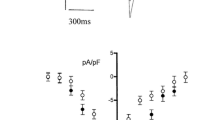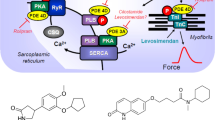Abstract
In the present work, the influence of intracellular injection of angiotensin-(1–12) [Ang-(1–12)] on the electrical properties of the intact left ventricle of Wistar Kyoto rats was investigated with electrophysiological methods. Particular attention was given to the role of chymostatin on the effect of the peptide. The results indicated that intracellular administration of the peptide elicited a depolarization of the surface cell membrane and an increase of duration of the action potential followed by the generation of early afterdepolarizations. The increment of action potential duration caused by Ang-(1–12) (100 nM) was due to a decrease of total potassium current recorded from single cardiomyocytes using the whole cell configuration of pCAMP. The decrease of potassium current was related to the activation of protein kinase C (PKC) because the specific inhibitor of kinase C, Bis-1 (10−9 M), abolished Ang-(1–12) effects on the potassium current. The question of whether the effect of Ang-(1–12) was related to the formation of Ang II by chymase was investigated.The results revealed that the intracellular administration of chymostatin, a chymase inhibitor (10−9 M) abolished the effect of intracellular Ang-(1–12) on the potassium current. Moreover, intracellular Ang II (100 nM), by itself, reduced the potassium current, an effect decreased by intracellular valsartan (100 nM). Valsartan (10–9 M) dialyzed into the cell abolished the effect of Ang-(1–12) (100 nM). These observations demonstrate that the effect of Ang-(1–12) on potassium current was related to the formation of Ang II and that the peptide has arrhythmogenic properties.











Similar content being viewed by others
References
Nagata S, Varagic J, Kon ND, Wang H, Groban L, Simington SW, Ahmad S, Dell’Italia LJ, VonCannon JL, Deal D, Ferrario CM (2015) Differential expression of the angiotensin-(1–12)/chymase axis in human atrial tissue. Ther Adv Cardiovasc Dis 9(4):168–180. doi:10.1177/1753944715589717
Ahmad S, Varagic J, Groban L, Dell’Italia LJ, Nagata S, Kon ND, Ferrario CM (2014) Angiotensin-(1–12): a chymase-mediated cellular angiotensin II substrate. Curr Hypertens Rep 16(5):429. doi:10.1007/s11906-014-0429-9
Ferrario CM, Ahmad S, Nagata S, Simington SW, Varagic J et al (2014) An evolving story of angiotensin II forming pathways in rodents and humans. Clin Sci 126:461–469
Zheng J, Wei CC, Hase N, Shi K, Killingsworth CR, Litovsky SH (2014) Chymase mediates injury and mitochondrial damage in cardiomyocytes during acute ischemia/reperfusion in the dog. PLoS One 9(4):e94732. doi:10.1371/journal.pone.0094732
Arnold AC, Isa K, Shaltout HA et al (2010) Angiotensin-(1–12) requires angiotensin converting enzyme and AT1 receptors for cardiovascular actions within the solitary tract nucleus. Am J Physiol Heart Circ Physiol 299(3):H763–H771
De Mello WC (2001) Cardiac arrhythmias: the possible role of the renin-angiotensin system. J Mol Med 79(2–3):103–108
De Mello WC (1994) Is an intracellular renin angiotensin system involved in the control of cell communication in heart? J Cardiovasc Pharmacol 23:640–646
De Mello WC, Danser AHJ (2000) Angiotensin II and the heart on the intracrine renin angiotensin system. Hypertension 35:1183–1188. doi:10.1161/01.HYP.35.6.1183
Kurdi M, De Mello WC, Booz GW (2005) Working outside the system: an update on unconventional behavior of the renin angiotensin system components. Int J Biochem Cell Biol 37:1357–1367. doi:10.1016/j.biocel.2005.01.012
Re RN, Cook JL (2008) The basis of an intracrine physiology. J Clin Pharmacol 48:344–350. doi:10.1177/0091270007312155
Kumar R, Singh VP, Baker KM (2008) The intracellular renin angiotensin system: implications in cardiovascular remodeling. Curr Opin Nephrol Hypertens 17:168–173. doi:10.1097/MNH.0b013e3282f521a8
De Mello WC (2006) On the pathophysiological implications of an intracellular renin receptor. Circ Res 99:1285–1286. doi:10.1161/01.RES.0000253141.65450.fc
Serneri GGN, Boddi M, Cecioni I, Vanni S, Coppo M, Papa ML et al (2001) Cardiac angiotensin II formation in the clinical course of heart failure and its relationship with left ventricular function. Circ Res 88:961–968. doi:10.1161/hh0901.089882
Danser AH, van Kats JP, Admiraal PJ, Derkx FH, Lamers JM, Verdouw PD et al (1994) Cardiac renin and angiotensins. Uptake from plasma versus in situ synthesis. Hypertension 24(1):37–48. doi:10.1161/01.HYP.24.1.37
Ahmad S, Varagic J, Westwood BM et al (2011) Uptake and metabolism of the novel peptide angiotensin-(1–12) by neonatal cardiac myocytes. PLoS One 6(1):e15759
De Mello WC (2013) Intracellular renin alters the electrical properties of the intact heart ventricle of adult Sprague Dawley rats. Regul Pept 10(181):45–49. doi:10.1016/j.regpep.2012.12.015
Jessup JA, Trask AJ, Chappell MC, Nagata S, Kato J, Kitamura K, Ferrario CM (2008) Localization of the novel angiotensin peptide, angiotensin-(1–12), in heart and kidney of hypertensive and normotensive rats. Am J Physiol Heart Circ Physiol 294(6):H2614–H2618
Levy MN, Wiseman MN (1991) Electrophysiologic mechanisms for ventricular arrhythmias in left ventricular dysfunction: electrolytes, catecholamines and drugs. J Clin Pharmacol 31:1053–1060
Marban E, Robinson SW, Wier WG (1986) Mechanisms of arrhythmogenic delayed and early afterdepolarizations in ferret ventricular muscle. J Clin Invest 78:1185–1192
Janse MJ, Wit AL (1989) Electrophysiological mechanisms of ventricular arrhythmias resulting from myocardial ischemia and infarction. Physiol Rev 69:1049–1169
Seylera C, Zhangb W, Scherera D, Völkersa M, Bloehsa R et al (2011) Central role of PKCα in isoenzyme-selective regulation of cardiac transient outward current I to and Kv4.3 channels. J Mol Cell Cardiol 51:722–729
De Mello WC, Frohlich ED (2014) Clinical perspectives and fundamental aspects of local cardiovascular and renal renin-angiotensin systems. Front Endocrinol 19:5–16. doi:10.3389/fendo.2014.00016
Zhuo JL, Li XC, Jeffrey L, Garvin L et al (2006) Intracellular Ang II induces cytosolic Ca2+ mobilization by stimulating intracellular AT1 receptors in proximal tubule cells. Am J Physiol 290:F1382–F1390
Ferrario CM, Jessup J, Chappell MC, Averill DB, Brosnihan KB, Tallant EA, Diz DI, Gallagher PE (2005) Effect of angiotensin-converting enzyme inhibition and angiotensin II receptor blockers on cardiac angiotensin-converting enzyme 2. Circulation 111(20):2605–2610
De Mello WC (1998) Intracellular angiotensin II regulates the inward calcium current in cardiac myocytes. Hypertension 32:076–082. doi:10.1161/01.HYP.32.6.976
Acknowledgments
The authors acknowledge the partial support that was provided for this study from Program Project Grant 2P01-HL051952 from the National Heart, Lung, and Blood Institute (NHLBI) to (F CM) and Institutional NIH GM61838 (WCM).
Author’s contribution
Dr. WC De Mello performed the electrophysiological experiments and organized the text. Dr. CM Ferrario, Dr. J Varajic, and Dr. L D’Italia performed the immunochemistry studies and revised the text.
Author information
Authors and Affiliations
Corresponding author
Rights and permissions
About this article
Cite this article
De Mello, W.C., Dell’Itallia, L.J., Varagic, J. et al. Intracellular angiotensin-(1–12) changes the electrical properties of intact cardiac muscle. Mol Cell Biochem 422, 31–40 (2016). https://doi.org/10.1007/s11010-016-2801-3
Received:
Accepted:
Published:
Issue Date:
DOI: https://doi.org/10.1007/s11010-016-2801-3




